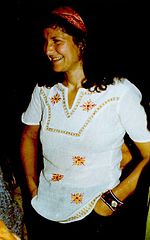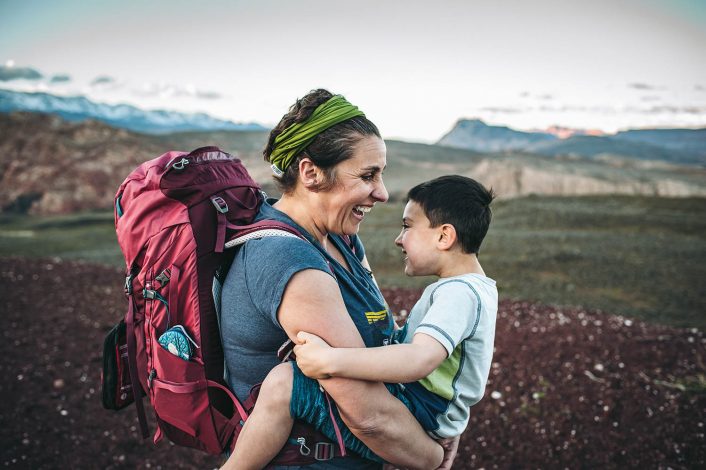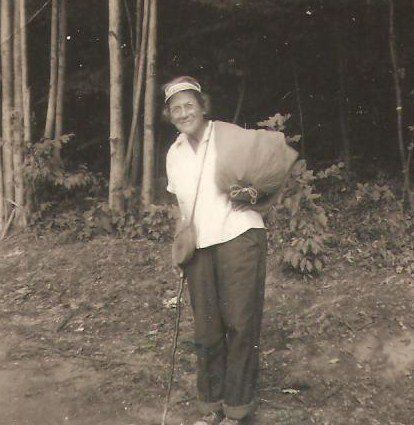Outdoor Moms Making a Difference that Everyone Should Know
- Blog Outdoor Moms Making a Difference that Everyone Should Know
When I started my research on outdoor moms, I honestly only knew of a handful of women that made a significant impact on the outdoor space. But, after a quick Google search, I was blown away by how many women have contributed to the environmental movement and have made advancements for women in outdoor recreation in the last century. This list is just a fraction of the remarkable female conservationists and outdoor enthusiasts, however, it includes women that were also mothers at the time of their most significant work. For many listed here, it is being a woman and a mom that fueled their passion to leave the world a better place than they found it. The list also includes some of our contemporary outdoor mamas who are paving the way for the current generation.  Arlene Blum at an event for the 1978 American Women's Himalayan Expedition to climb Annapurna. (Image: Cullen328)
Arlene Blum at an event for the 1978 American Women's Himalayan Expedition to climb Annapurna. (Image: Cullen328)
Arlene Blum
“[motherhood is] life’s best and most challenging adventure.”
Arlene Blum fell in love with climbing as a college student at Reed College in Portland, Oregon in the 1960s. In addition to earning a PhD in biochemistry and embarking on a successful career as a biophysical chemist she also has a storied climbing career. Arlene was part of the first all-woman team to ascend Alaska's Mount Denali in 1970. In 1978, she led a team of eleven women to climb the tenth highest mountain in the world, Annapurna (I) in Nepal which, until then, had been climbed by only eight people, all men. She led the first expedition to climb Bhrigupanth in the Indian Himalayas, leading a team of Indian and American women. In July of 1981, over the course of three months, she walked 900 miles across the Alps, from Yugoslavia to France, with her 4-month-old daughter on her back. She has said motherhood is “life’s best and most challenging adventure.” Arlene has written two books, Annapurna: A Woman's Place and Breaking Trail: A Climbing Life.
Patricia “Trish” Ellis-Herr
Patricia Ellis-Herr documented hiking all 48 of New Hampshire’s highest mountains with her 5-year-old daughter, Alex in her memoir Up: A Mother and Daughter’s Peakbagging Adventure. In 2013, her two daughters joined her on a 500-mile hike along El Camino de Santiago to raise money for the Global Fund for Women and GirlVentures. In 2014, the trio hiked the John Muir trail raising money for Feeding America. You can read about their hiking adventures in their blog. Trish hopes to inspire other parents who want to facilitate their children's love of the outdoors and show young girls and women that hiking is a woman’s sport, too.
 Shanti Hodges and her son Mason. (Image: Michelle Craig)
Shanti Hodges and her son Mason. (Image: Michelle Craig)
Shanti Hodges
Shanti Hodges is the founder of Hike it Baby and Hiking My Way Retreats and author of the book, Hike It Baby: 100 Awesome Outdoor Adventures with Babies and Toddlers. Hike it Baby started in 2013 in Portland, Oregon when Shanti noticed everyone in her new mom group sitting inside on a beautiful sunny day. She casually invited a couple of families to join her for a hike with her new baby and so began a new community of families exploring the outdoors together with very young children. Hike it Baby is now a national non-profit organization with over 400 branches that get almost 280,000 families on trail each year.
Aurora Castillo
In 1984, Aurora Castillo, a fourth-generation Mexican-American in her seventies, formed the Mothers of East Los Angeles (MELA). MELA has been nationally recognized as an environmental organization that has been given credit for the defeat of several environmentally threatening projects. Among these projects were a state prison, a toxic waste incinerator, a hazardous waste treatment plant, and an oil pipeline. Aurora was awarded the prestigious Goldman Environmental Prize in 1995 for her work. She was the oldest person and first Latina to receive the Goldman Environmental Prize. Although she never birthed children of her own, her work was rooted in the health and safety of the children in her community and was affectionately known as “Nina,” short for madrina, or godmother. She passed away in 1988 at the age of 84.
Teddi Boston
In 1976 at the age of 49, mother of four Teddi was the first female thru-hiker to complete the Pacific Crest Trail (PCT) traveling north to south. She started at the Canadian border and ended at the Mexican Border saying she did it the reverse to the usual direction because she was told it was impossible. Teddi started backpacking in the San Bernardino Mountains in the 1960s when two of her daughters were in Girl Scouts. In 1972 she took eight girls on the full John Muir Trail hike (a 215-mile trail from Yosemite to Mount Whitney). Jack Haskel of the Pacific Crest Trail Association says Boston has a lasting legacy in the hiking community. “People recognize her as one of the early solo female hikers, and today there’s a lot of solo women out on the PCT, and Teddi is one of them that pioneered that,” he said.
Helen Engle
Helen Engle was an American conservationist and activist, and mom of seven focused on wildlife and natural space preservation in the northwest United States. She co-founded various environmental organizations, including the Tahoma Audubon Society, the Washington Environmental Council, Washington Wilderness Coalition, The Arboretum Foundation, Nisqually Land Trust, and Citizens for a Healthy Bay in Tacoma. She left nursing in the 1950s after the birth of her third child, and with her husband, joined a local hiking group. Her environmental awakening occurred not long after when she discovered a local copper smelter was sending out a toxic plume that contained arsenic, lead, and other heavy metals. She went on to become a pillar of conservation in her community. Engle died in her home at University Place on March 11, 2019.
 Emma "Grandma" Gatewood (Image: Stratness)
Emma "Grandma" Gatewood (Image: Stratness)
Grandma Gatewood
“If those men can do it, I can do it.”
Emma “Grandma” Gatewood was the first woman to hike the entire 2,050 miles of the Appalachian Trail by herself in 1955. She was 67 years old at the time, a mom of 11 and grandmother of 23. She’d survived more than 30 years of marriage to a brutal husband who beat her repeatedly. She would go on to hike the Appalachian Trail two more times, walked nearly 2,000 miles in 95 days from Independence, MO to Portland, OR as part of the Oregon Centennial celebration, and was instrumental in the creation of the Buckeye Trail in her home state of Ohio. Her daughter, Lucy Gatewood Seeds, has said in interviews she believes the fact that no woman had yet hiked the Appalachian trail presented a challenge to her mother. An obituary quoted daughter Rowena saying her mother stated, “If those men can do it, I can do it.” You can read more about her hikes and life story in Ben Montgomery’s biography Grandma Gatewood’s Walk: The Inspiring Story of the Woman Who Saved the Appalachian Trail.
Justine Nobbe + Stephanie Feller
After Adventure Mamas Initiative (AMI) co-founders and longtime friends Justine Nobbe and Stephanie Feller both became mothers in 2015, they were confronted with traditional maternal stereotypes. Instead of feeling discouraged, they became determined to push back knowing their adventures were an integral part of self-care. This was the catalyst for the Adventure Mamas Initiative to be born.
Justine has enjoyed the hilarious learning curve of integrating little ones into her dirtbag lifestyle. She’s accumulated over 250 professional trail days as an adventure therapy guide and field director, completed thousands of miles of self-supported bike touring and backpacking, and rock climbed around the country.
By day, Stephanie is a full-time digital art director and after hours, she commits her energy to propel the mission of AMI. “I want women to know that regardless of location, experience, kids, or age, they can set big goals and pursue adventurous challenges.”
Heather ‘Mamma Bear’ Burror
In April of 2012, Heather ‘Mamma Bear’ Burror, a second-grade teacher, helped her 8-year-old daughter Sierra ‘Monkey’ Burror become the youngest person to thru-hike the Pacific Crest Trail. The mom and daughter hiked between 10 and 24 miles every day to complete their 2,600-mile trek ahead of schedule. The mother-daughter pair also hiked the 500-mile Colorado trail in 2013 and a large section of the Continental Divide Trail in 2014.
Lucia Pychowska
In the 1870s, Hoboken, NJ resident Lucia Pychowska began spending her summers in the White Mountains with her daughter Marian and a small group of fellow mountaineers. They were among a select few who enjoyed exploring the White Mountain backcountry in the 1870s. And, at the age of twelve, Marian was already an experienced hiker. While we don’t know how many “firsts” these women made, their importance lies more in their explorations of the mountains. Through original letters, Lucia, Marian, Lucia’s sister Edith, and their friend and fellow mountaineer, Isabella Stone document their adventures, exploration, and love of the mountains.
About Hike it Baby
Related Content




Comments